Is TCR/pMHC Affinity a Good Estimate of the T-cell Response? An Answer Based on Predictions From 12 Phenotypic Models
- PMID: 30886616
- PMCID: PMC6410681
- DOI: 10.3389/fimmu.2019.00349
Is TCR/pMHC Affinity a Good Estimate of the T-cell Response? An Answer Based on Predictions From 12 Phenotypic Models
Abstract
On the T-cell surface the TCR is the only molecule that senses antigen, and the engagement of TCR with its specific antigenic peptide (agonist)/MHC complex (pMHC) is determined by the biochemical parameters of the TCR-pMHC interaction. This interaction is the keystone of the adaptive immune response by triggering intracellular signaling pathways that induce the expression of genes required for T cell-mediated effector functions, such as T cell proliferation, cytokine secretion and cytotoxicity. To study the TCR-pMHC interaction one of its properties most extensively analyzed has been TCR-pMHC affinity. However, and despite of intensive experimental research, the results obtained are far from conclusive. Here, to determine if TCR-pMHC affinity is a reliable parameter to characterize T-cell responses, a systematic study has been performed based on the predictions of 12 phenotypic models. This approach has the advantage that allow us to study the response of a given system as a function of only those parameters in which we are interested while other system parameters remain constant. A little surprising, only the simple occupancy model predicts a direct relationship between affinity and response so that an increase in affinity always leads to larger responses. Conversely, in the others more elaborate models this clear situation does not occur, i.e., that a general positive correlation between affinity and immune response does not exist. This is mainly because affinity values are given by the quotient kon/koff where kon and koff are the rate constants of the binding process (i.e., affinity is in fact the quotient of two parameters), so that different sets of these rate constants can give the same value of affinity. However, except in the occupancy model, the predicted T-cell responses depend on the individual values of kon and koff rather than on their quotient kon/koff. This allows: a) that systems with the same affinity can show quite different responses; and b) that systems with low affinity may exhibit larger responses than systems with higher affinities. This would make affinity a poor estimate of T-cell responses and, as a result, data correlations between affinity and immune response should be interpreted and used with caution.
Keywords: T-cell activation; TCR-pMHC interaction; affinity; correlation between affinity immune response; phenotypic models.
Figures



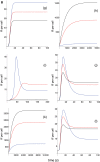

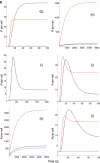

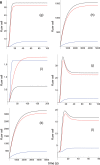


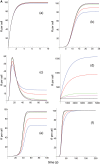

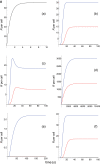
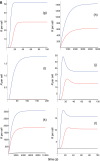
Similar articles
-
T-cell receptor triggering is critically dependent on the dimensions of its peptide-MHC ligand.Nature. 2005 Jul 28;436(7050):578-82. doi: 10.1038/nature03843. Nature. 2005. PMID: 16049493
-
The kinetics of two-dimensional TCR and pMHC interactions determine T-cell responsiveness.Nature. 2010 Apr 8;464(7290):932-6. doi: 10.1038/nature08944. Epub 2010 Mar 31. Nature. 2010. PMID: 20357766 Free PMC article.
-
Fast on-rates allow short dwell time ligands to activate T cells.Proc Natl Acad Sci U S A. 2010 May 11;107(19):8724-9. doi: 10.1073/pnas.1000966107. Epub 2010 Apr 26. Proc Natl Acad Sci U S A. 2010. PMID: 20421471 Free PMC article.
-
Modulation of T cell function by TCR/pMHC binding kinetics.Immunobiology. 2006;211(1-2):47-64. doi: 10.1016/j.imbio.2005.09.003. Epub 2006 Jan 4. Immunobiology. 2006. PMID: 16446170 Review.
-
Correlation of a dynamic model for immunological synapse formation with effector functions: two pathways to synapse formation.Trends Immunol. 2002 Oct;23(10):492-9. doi: 10.1016/s1471-4906(02)02285-8. Trends Immunol. 2002. PMID: 12297421 Review.
Cited by
-
Multi-strain modeling of influenza vaccine effectiveness in older adults and its dependence on antigenic distance.Sci Rep. 2024 Nov 8;14(1):27190. doi: 10.1038/s41598-024-72716-1. Sci Rep. 2024. PMID: 39516205 Free PMC article.
-
The Quest for the Best: How TCR Affinity, Avidity, and Functional Avidity Affect TCR-Engineered T-Cell Antitumor Responses.Cells. 2020 Jul 18;9(7):1720. doi: 10.3390/cells9071720. Cells. 2020. PMID: 32708366 Free PMC article. Review.
-
The Enigmatic Nature of the TCR-pMHC Interaction: Implications for CAR-T and TCR-T Engineering.Int J Mol Sci. 2022 Nov 25;23(23):14728. doi: 10.3390/ijms232314728. Int J Mol Sci. 2022. PMID: 36499057 Free PMC article. Review.
-
Modulating T Cell Responses by Targeting CD3.Cancers (Basel). 2023 Feb 13;15(4):1189. doi: 10.3390/cancers15041189. Cancers (Basel). 2023. PMID: 36831533 Free PMC article. Review.
-
Empirical and Rational Design of T Cell Receptor-Based Immunotherapies.Front Immunol. 2021 Jan 25;11:585385. doi: 10.3389/fimmu.2020.585385. eCollection 2020. Front Immunol. 2021. PMID: 33569049 Free PMC article. Review.
References
MeSH terms
Substances
LinkOut - more resources
Full Text Sources
Research Materials

